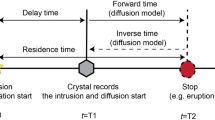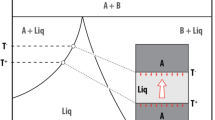Abstract
The paper summarizes the principal results obtained over the past three decades at the Vernadsky Institute and the Department of Geochemistry of the Moscow State University by the computer simulation of basaltic magma differentiation in magma chambers. The processes of diffusion-controlled mass transfer in a chamber are demonstrated to be principally limited by the heat resources of the cooling magma and cannot play any significant role during the large-scale partitioning of melt components. The leading mass-transfer mechanism is the settling of crystals from convecting magma in the form of suspension flows that are enriched and depleted in the solid phase. The physical prerequisite for the onset of this concentration convection is the existence of boundary layers, which are characterized by volume crystallization and a gradient distribution of the suspended phases. Considered in detail are the principles used in the development of algorithms with regard for the occurrence of a boundary layer and the “instantaneous” stirring of the crystallizing magma that does not hamper the settling of mineral grains forming the cumulus. The plausibility of the convection-accumulation model is illustrated by the example of the reconstructed inner structure of differentiated Siberian traps. In application to these bodies, it is demonstrated that the solutions of the forward and inverse simulation problems with the use of geochemical thermometry techniques are identical. This is a convincing argument for the predominance of convection-accumulation processes during the formation of thin tabular magmatic bodies. The further development of the computer model for the differentiation dynamics should involve the processes of compositional convection related to the migration and reactivity of the intercumulus melt.
Similar content being viewed by others
References
M. Ya. Frenkel, “The Thermodynamics, Dynamics, and Mathematical Modeling of Geochemical Systems,” Geokhimiya, No. 10, 1401–1411 (1992).
M. Ya. Frenkel and A. A. Yaroshevsky, “The Crystallization Differentiation of Intrusive Magma: The Diffusion Mechanism for Heat and Mass Transfer,” Geokhimiya, No. 8, 1197–1203 (1976).
M. Ya. Frenkel and A. A. Yaroshevsky, “The Crystallization Differentiation of Intrusive Magma: Convection and Freezing-on Conditions,” Geokhimiya, No. 11, 1624–1632 (1976).
M. Ya. Frenkel and A. A. Yaroshevsky, “A Set of Equations for Heat and Mass Transfer during the Emplacement of a Tabular Intrusive Body: Problem Formulation and a Computer Algorithm for Its Solution,” Geokhimiya, No. 4, 547–559 (1978).
M. Ya. Frenkel and A. A. Yaroshevsky, “The Crystallization Differentiation of Intrusive Magma: Mathematical Modeling of the Thermal Conditions and Differentiation of an Tabular Intrusive Body with Regard for Solid Phase Sedimentation,” Geokhimiya, No. 5, 643–668 (1978).
E. V. Koptev-Dvornikov, A. A. Yaroshevsky, and M. Ya. Frenkel, “Crystallization Differentiation of Intrusive Magma: The Advantages and Disadvantages of the Sedimentation Model,” Geokhimiya, No. 4, 488–508 (1979).
M. Ya. Frenkel, A. A. Yaroshevsky, E. V. Koptev-Dvornikov, et al., “The Crystallization Mechanism in the Genesis of Layered Intrusions,” Zap. Vsess. Mineral. O-va CXIV (3), 257–274 (1985).
M. Ya. Frenkel, A. A. Yaroshevsky, A. A. Ariskin, et al., Dynamics of Basic Magma Differentiation in Chambers (Nauka, Moscow, 1988) [in Russian].
V. N. Sharapov and A. N. Cherepanov, The Dynamics of Magma Differentiation (Nauka, Novosibirsk, 1986) [in Russian].
C. Jaupart and S. Tait, “Dynamics of Differentiation in Magma Reservoirs,” J. Geophys. Res. 100, 17615–17636 (1995).
N. L. Bowen, The Evolution of the Igneous Rocks (Princeton Univ. Press, Princeton, 1928).
H. H. Hess, Stillwater Igneous Complex, Montana: A Quantitative Mineralogical Study (1960).
L. R. Wager and G. M. Brown, Layered Igneous Rocks (Oliver, Edinburgh, 1967; Mir, Moscow, 1970).
E. D. Jackson, “Primary Textures and Mineral Associations in the Ultramafic Zone of the Stillwater Complex, Montana,” US Geol. Surv. Prof. Pap. 358, 1–106 (1961).
I. H. Campbell, “Some Problems with the Cumulus Theory,” Lithos 11, 311–323 (1978).
A. R. McBirney and R. M. Noyes, “Crystallization and Layering of the Skaergaard Intrusion,” J. Petrol. 20, 487–554 (1979).
R. W. Bartlett, “Magma Convection, Temperature Distribution, and Differentiation,” Am. J. Sci. 267, 1067–1082 (1969).
A. P. Vinogradov and A. A. Yaroshevsky, “Physical Conditions of Zoned Melting in the Earth,” Geokhimiya, No. 7, 779–790 (1965).
R. G. Cawthorn and T. S. McCarthy, “Incompatible Trace Element Behavior in the Bushveld Complex,” Econ. Geol. 80, 1016–1026 (1985).
E. V. Sharkov, The Petrology of Layered Intrusions (Nauka, Leningrad, 1980) [in Russian].
N. I. Gel’perin and G. A. Nosov, The Basis of the Mechanism for Melt Crystallization (Khimiya, Moscow, 1975) [in Russian].
M. Ya. Frenkel, The Heat and Chemical Dynamics of Basic Magma Crystallization (Nauka, Moscow, 1995) [in Russian].
A. N. Tikhonov and A. A. Samarskii, Equations of Mathematical Physics (Nauka, Moscow, 1966) [in Russian].
M. G. Worster, H. E. Huppert, and R. S. J. Sparks, “Convection and Crystallization in Magma Cooled from Above,” Earth Planet. Sci. Lett. 101, 78–89 (1990).
M. T. Mangan and B. D. Marsh, “Solidification Front Fractionation in Phenocryst-free Sheet-like Magma Bodies,” J. Geol. 100, 605–620 (1992).
A. Simakin, V. Trubitsyn, and H. Schmeling, “Structure of the Boundary Layer of a Solidifying Intrusion with Crystal Sedimentation,” Earth Planet. Sci. Lett. 126, 333–349 (1994).
B. D. Marsh, “Solidification Fronts and Magmatic Evolution,” Mineral. Mag. 60, 5–40 (1995).
V. N. Sharapov, A. N. Cherepanov, V. N. Popov, and A. G. Lobov, “Dynamics of Basic Melt Cooling during the Filling of a Funnel-shaped Intrusive Chamber,” Petrologiya 5 (1), 10–22 (1997) [Petrology 5 (1), 8–19 (1997)].
R. T. Helz, “Crystallization History of Kilauea Iki Lava Lake as Seen in Drill Core Recovered in 1967–1979,” Bull. Volcanol. 43, 675–701 (1980).
R. T. Helz, “Differentiation Behavior of Kilauea Lava Lake, Kilauea Volcano, Hawaii: An Overview of Past and Current Work,” in Magmatic Processes: Physicochemical Principles, Ed. by B. O. Mysen, Geochem. Soc. Spec. Publ. 1, 241–258 (1987).
S. Tait and C. Jaupart, “The Production of Chemically Stratified and Adcumulate Plutonic Igneous Rocks,” Mineral. Mag. 60, 99–114 (1996).
V. P. Trubitsyn and E. V. Kharybin, “Convection in Magma Chambers due to Inversion of Vertical Distribution of Deposited Crystals,” Fiz. Zemli, No. 5, 47–52 (1997).
M. Ya. Frenkel and A. A. Ariskin, “The Problem of Equilibrium Crystallization for the Basaltic Melt: An Algorithm of Computer-based Solution,” Geokhimiya, No. 5, 679–690 (1984).
M. Ya. Frenkel and A. A. Ariskin, “Computer-based Modeling of Equilibrium and Fractional Crystallization under Determined Oxygen Fugacity,” Geokhimiya, No. 10, 1419–1431 (1984).
A. A. Ariskin, G. S. Barmina, and M. Ya. Frenkel, “Crystallization of Basaltic Melts under Determined Oxygen Fugacity: Computer-based Modeling,” Geokhimiya, No. 11, 1614–1628 (1986).
P. L. Roeder and E. Emslie, “Olivine-Liquid Equilibrium,” Contrib. Mineral. Petrol. 29, 275–289 (1970).
M. J. Drake, “Plagioclase-Melt Equilibria,” Geochim. Cosmochim. Acta 40, 457–465 (1976).
R. L. Nielsen and M. J. Drake, “Pyroxene-Melt Equilibria,” Geochim. Cosmochim. Acta 43, 1259–1272 (1979).
A. A. Ariskin and G. S. Barmina, Modeling of Phase Equilibria for the Crystallization of Basaltic Magmas (Nauka, Moscow, 2000) [in Russian].
A. A. Ariskin, G. S. Barmina, M. Ya. Frenkel, and R. L. Nielsen, “COMAGMAT: A Fortran Program to Model Magma Differentiation Processes,” Comput. Geosci. 19, 1155–1170 (1993).
A. A. Ariskin, “Phase Equilibria Modeling in Igneous Petrology: Use of COMAGMAT Model for Simulating Fractionation of Ferro-basaltic Magmas and the Genesis of High Alumina Basalt,” J. Volcanol. Geotherm. Res. 90, 115–162 (1999).
M. Ya. Frenkel, “The Geochemical Structure of a Tabular Intrusion,” in Dynamic Models in Physical Geochemistry (Nauka, Novosibirsk, 1982), pp. 19–30 [in Russian].
M. Ya. Frenkel, A. A. Yaroshevsky, A. A. Arislin, et al., “Convective-Cumulative Model Simulating the Formation Process of Stratified Intrusions,” in Magma-Crust Interactions and Evolution, Ed. by B. Bonin (Theophrastus Publications, Athens, 1989), pp. 3–88.
E. V. Koptev-Dvornikov, E. E. Kameneva, B. S. Kireev, and A. A. Yaroshevsky, “Evidence for the Cumulus Origin of Clinopyroxene and for the Reequilibration of Olivine in Vavukan-Sill Dolerites,” Geochem. Int. 33 (1), 81–102 (1996).
A. I. Shapkin, Doctoral Dissertation in Chemistry (GEOKhI, Moscow, 1998).
M. Ya. Frenkel, A. A. Ariskin, G. S. Barmina, et al., “Geochemical Thermometry of Igneous Rocks: Principles and Examples,” Geokhimiya, No. 11, 1546-1562 (1987).
A. A. Ariskin and G. S. Barmina, “COMAGMAT: Development of a Magma Crystallization Model and Its Petrologic Applications,” Geochem. Int. 42 (Suppl. 1), S1–S157 (2004).
G. S. Barmina, M. Ya. Frenkel, A. A. Yaroshevsky, and A. A. Ariskin, “Crystallization-related Redistribution of Trace Elements in Sheet Intrusions,” in Dynamic Models in Physical Geochemistry (Nauka, Novosibirsk, 1982), pp. 45–55 [in Russian].
G. S. Barmina, A. A. Ariskin, E. V. Koptev-Dvornikov, and M. Ya. Frenkel, “Experience in Studying the Composition of Primary Cumulus Minerals in Differentiated Traps,” Geokhimiya, No. 8, 1108–1119 (1988).
R. H. Hunter, “Texture Development in Cumulate Rocks,” in Layered Intrusions (Elsevier, New York, 1996), pp. 77–101.
R. M. Latypov, “The Origin of in Basic-Ultrabasic Sills with S-, D-, and I-shaped Compositional Profiles by in situ Crystallization of a Single Input of Phenocryst-poor Parental Magma,” J. Petrol. 44, 1619–1656 (2003).
R. M. Latypov, “The Origin of Marginal Compositional Reversals in Basic-Ultrabasic Sills and Layered Intrusions by Soret Fractionation,” J. Petrol. 44, 1579–1618 (2003).
A. A. Yaroshevsky, “Physicochemical Principles in the Behavior of a Magmatic System in the Gravitational Field with a Low Fraction of Melt: Melt Segregation and Cumulus Development,” Geokhimiya, No. 6, 670–675 (2003) [Geochem. Int. 41 (6), 603–608 (2003)].
T. N. Irvine, “Magmatic Infiltration Metasomatism, Double-diffusive Fractional Crystallization, and Adcumulus Growth in the Muskox Intrusion and Other Layered Intrusions,” in Physics of Magmatic Processes (Princeton Univ. Press, Princeton, 1980), pp. 325–384.
S. Tait and C. Jaupart, “Compositional Convection in a Reactive Crystalline Mush and Melt Differentiation,” J. Geophys. Res. 97, 6735–6756 (1992).
C. H. Langmuir, “Geochemical Consequences of In Situ Crystallization,” Nature 340, 199–205 (1989).
R. L. Nielsen and S. E. DeLong, “A Numerical Approach to Boundary Layer Fractionation: Application to Differentiation in Natural Magma Systems,” Contrib. Mineral. Petrol. 110, 355–369 (1992).
A. E. Boudreau and W. P. Meurer, “Chromatographic Separation of the Platinum-Group Elements, Gold, Base Metals, and Sulfur during Degassing of a Compacting and Solidifying Igneous Crystal Pile,” Contrib. Mineral. Petrol. 134, 174–185 (1999).
T. Kuritani, “Thermal and Compositional Evolution of a Cooling Magma Chamber by Boundary Layer Fractionation: Model and Its Application to Primary Magma Estimation,” Geophys. Rev. Lett. 26, 2029–2032 (1999).
Author information
Authors and Affiliations
Additional information
Original Russian Text © A.A. Ariskin, A.A. Yaroshevsky, 2006, published in Geokhimiya, 2006, No. 1, pp. 80–102.
Rights and permissions
About this article
Cite this article
Ariskin, A.A., Yaroshevsky, A.A. Crystallization differentiation of intrusive magmatic melt: Development of a convection-accumulation model. Geochem. Int. 44, 72–93 (2006). https://doi.org/10.1134/S0016702906010083
Received:
Issue Date:
DOI: https://doi.org/10.1134/S0016702906010083




